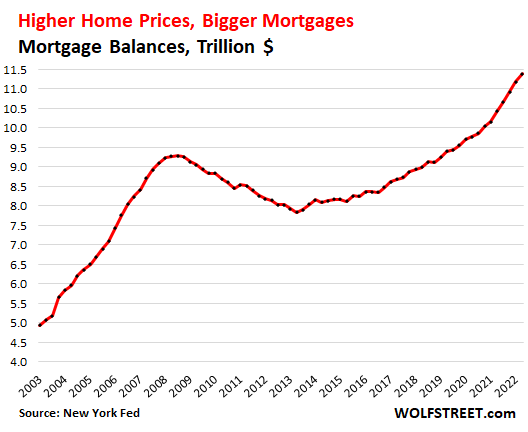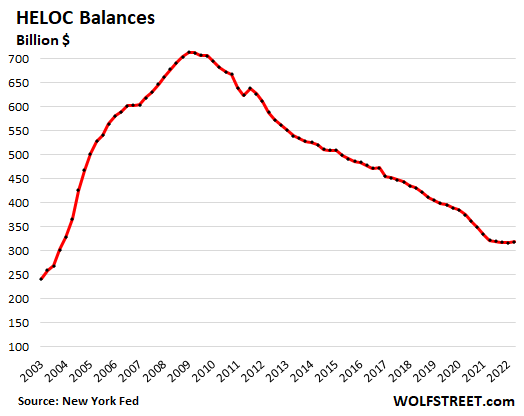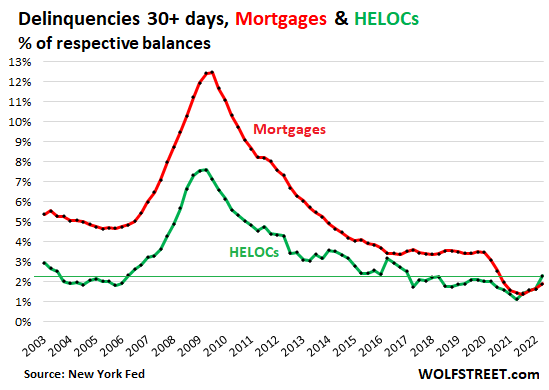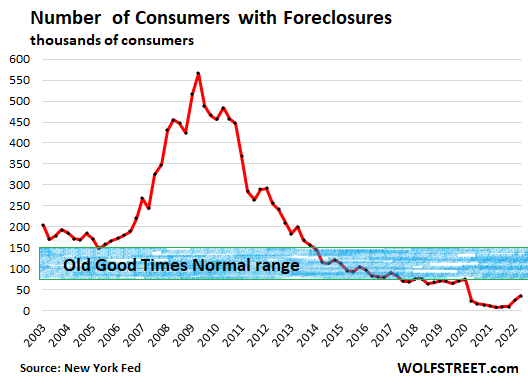Forbearance and pandemic cash run out. But a lot of fun was had by all.
By Wolf Richter for WOLF STREET.
Mortgage balances jumped by 9% in Q2 from a year ago, as prices spiked year-over-year, while people bought far fewer homes – sales of existing homes dropped by 10% from Q2 last year, and sales of new single-family houses plunged by 19% over the same period.
Mortgage balances have surged relentlessly since the end of the Housing Bust in 2012. Over those 10 years, mortgage balances surged by $4.6 trillion, and over the past three years, mortgage balances surged by $2.0 trillion, or by 21%, to $11.4 trillion.

HELOCs end long decline.
Home Equity Lines of Credit fell out of favor after 2009 and balances declined steadily, unwinding the massive surge of the years before the Financial Crisis. As the Fed’s interest-rate repression and QE pushed down mortgage rates, and as home prices rose, folks began to cash-out-refinance their mortgages to generate cash, rather than drawing on HELOCs.
But now the decline has ended. HELOC balances ticked up in Q2 to $319 billion, from the low in the prior quarter. This has occurred as mortgage rates have spiked, and as cash-out refis have plunged.
There is now a new dynamic in place: Much higher mortgage rates: It would be stupid to refinance a 3% mortgage with a 5% mortgage in order to draw $100,000 in cash out of the home. It’s better to leave the 3% mortgage alone, and get a $100,000 HELOC that charges 5% on the outstanding balance, if any. So I expect HELOC balances to rise further going forward because the cash-out refi game has changed.

Mortgages are by far the biggest part of consumer debt, bigger than ever.
Nothing comes even close. Consumer debt balances in Q2:
- Mortgages: $11.4 trillion
- Student loans: $1.6 trillion
- Auto loans: $1.5 trillion
- Credit cards: $890 billion
- “Other” (personal loans, etc.): $470 billion
- HELOCs: $320 billion.
Mortgages is where the big systemic risks used to be due to the sheer size of the market and the high leverage.
But now, commercial Banks in the US only hold about $2.4 trillion of residential mortgages, including HELOCs, on their balance sheets, and those are spread among 4,300 commercial banks. Thousands of Credit Unions and other lenders also hold some mortgages on their balance sheets.
But most mortgages are now securitized into mortgage-backed securities. MBS fall into two categories:
- Most are government-backed MBS. Here the taxpayer is on the hook, not investors and lenders.
- A smaller portion of MBS are “private label” – not backed by government entities. They’re held by global bond funds, pension funds, insurance companies, etc.
Delinquencies start trip back to reality. A lot of fun was had by all.
Under the pandemic-era forbearance programs, homeowners that fell behind on their mortgage payments, or stopped making mortgage payments altogether, and then entered into a forbearance program, were reclassified to “current” instead of delinquent. They didn’t have to make mortgage payments, and could use the cash saved from those not-made mortgage payments for other stuff. Eventually, they would have to work out a deal with the lender to exit the forbearance program.
The spike in home prices since spring 2020 allowed homeowners, when it came time to exit the forbearance program, to either sell the home and pay off the mortgage and walk away with extra cash; or work out a deal with the lender, such as a modified mortgage with a longer term, a lower rate, and lower payments. And a lot of fun was had by all.
But with forbearance programs over, mortgage delinquencies started to rise this year from the record lows last year.
Mortgage balances that were 30 days or more delinquent rose to 1.9% of total mortgage balances in Q2, up from 1.7% in Q1. It was the third quarter-to-quarter increase in a row, from the record low in Q2 2021. But it remains below all pre-pandemic low points (red line).
HELOC balances that were 30 days or more delinquent rose to 2.3% of total HELOC balances, the fourth quarter-to-quarter increase in a row, from the record low in Q2 2021. They’re now higher than they were before the Housing Bust (green line).
The HELOC delinquency rate in Q2 was higher than the mortgage delinquency rate for the first time ever, which makes you go hmmm.

Foreclosures rose, but are still near record lows.
The number of consumers with foreclosures rose to 35,120 borrowers, up from 24,240 in Q1 and up from the record low range of 8,100 to 9,600 last year.
Foreclosures are still far below any of the prior lows before the pandemic. At the low point in Q2 2005, during the Best of Times just before the Housing Bust took off, there were 148,780 foreclosures, over four times as many as now.
By comparison, during the three-year time span from 2008 through 2011, the peak of the mortgage crisis, over 400,000 consumers per quarter had foreclosures, including 566,180 at the peak in Q2 2009.
During the Best of Times before the Housing Bust, around 150,000 consumers had foreclosures; and during the Good Times before the pandemic, about 75,000 consumers had foreclosures per quarter. This range from 75,000 to 150,000 foreclosures might represent something like the old Good Times Normal (blue box), and we’re still not there yet:

Home prices and foreclosures.
A surge in foreclosures cannot happen unless there is a plunge in home prices. When a homeowner who’d bought the home two years ago for $400,000 gets in trouble now, when the home price has jumped by 25% to $500,000, they can just sell the home, pay off the mortgage, pay the fees, and walk away with left-over cash. And there won’t be a foreclosure.
If the price of that house drops 25% eventually to $375,000, and the borrower owes $390,000 on the mortgage, that exit is getting tougher.
If the price plunges by 40% to $300,000, the easy exit is closed. That’s when foreclosures are starting to happen in large numbers, especially if they’re accompanied by a large-scale surge in unemployment, and that’s what happened during the Mortgage Crisis. But that’s not on the table just yet.
Enjoy reading WOLF STREET and want to support it? Using ad blockers – I totally get why – but want to support the site? You can donate. I appreciate it immensely. Click on the beer and iced-tea mug to find out how:
Would you like to be notified via email when WOLF STREET publishes a new article? Sign up here.
![]()
Read More:Trip Back to Reality Starts: Mortgages, HELOCs, Delinquencies, and Foreclosures in Q2
2022-08-04 21:00:00

